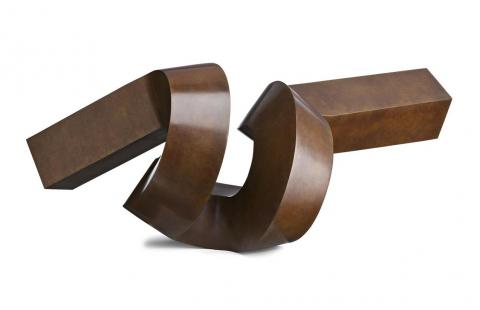HOB NOB, 1992
CLEMENT MEADMORE
bronze
43.0 x 101.0 x 53.0 cm
signed, dated and numbered at base: Meadmore 1992 5/6
dated, numbered and inscribed with title on base: ‘Hob Nob’ / 1992 5/6 / ART
Robin Gibson Gallery, Sydney
Sotheby’s, Melbourne, February 2016 (private sale)
Private collection, Melbourne
Sculpture 26, Robin Gibson Gallery, Sydney, March – April 2014
Gibson, E., The Sculpture of Clement Meadmore, Hudson Hills Press, New York, 1994, p. 133 (illus. another example)
Seeming to transport Paul Klee’s idea of ‘taking a line for a walk’ into three dimensions, Clement Meadmore’s sculptures are products of a marriage between pure stark geometry and expressive gesture. In the 1990s, the sculptor returned to his dense, coiled sculptures of the 1960s and 70s, and this free-flowing exchange of ideas within his own oeuvre produced masterful compositions such as Round Midnight, Up and Whirly Bird. With a title that evokes the idea of friendly (upward) social lubrication, Hob Nob’s form is endowed with an undeniable energy and movement. The torsion is palpable; the almost symmetrical protruding ends of its curl call to be outstretched, and pulled open like a ribbon tied in a bow.
The careful sense of balanced fluidity arrested in time and space is present in most of Meadmore’s sculptures, regardless of their scale. Many of them, including Hob Nob, 1992 were constructed of one single square-sectioned beam, bent and coiled into a final composition of implausible elastic potential. Meadmore created maquettes for each of his sculptures using custom-made modular building blocks, whose combinations created an infinite number of volumetric permutations. These creations came into being in an intuitive manner, improvised from a geometric vocabulary in a similar way to a Jazz improvisation. Meadmore was an aficionado of this modern genre, and as a result his works often carry a musical understanding of rhythm and movement: ‘Rhythms now gather and are released – they pick up momentum and slow down, begin with sudden intensity and stop with equal abruptness. His sculptures simultaneously suggest uninterrupted flow and caesura’.1
1. Gibson, E., The Sculpture of Clement Meadmore, Hudson Hills Press, New York, 1994, p. 57
LUCIE REEVES-SMITH
